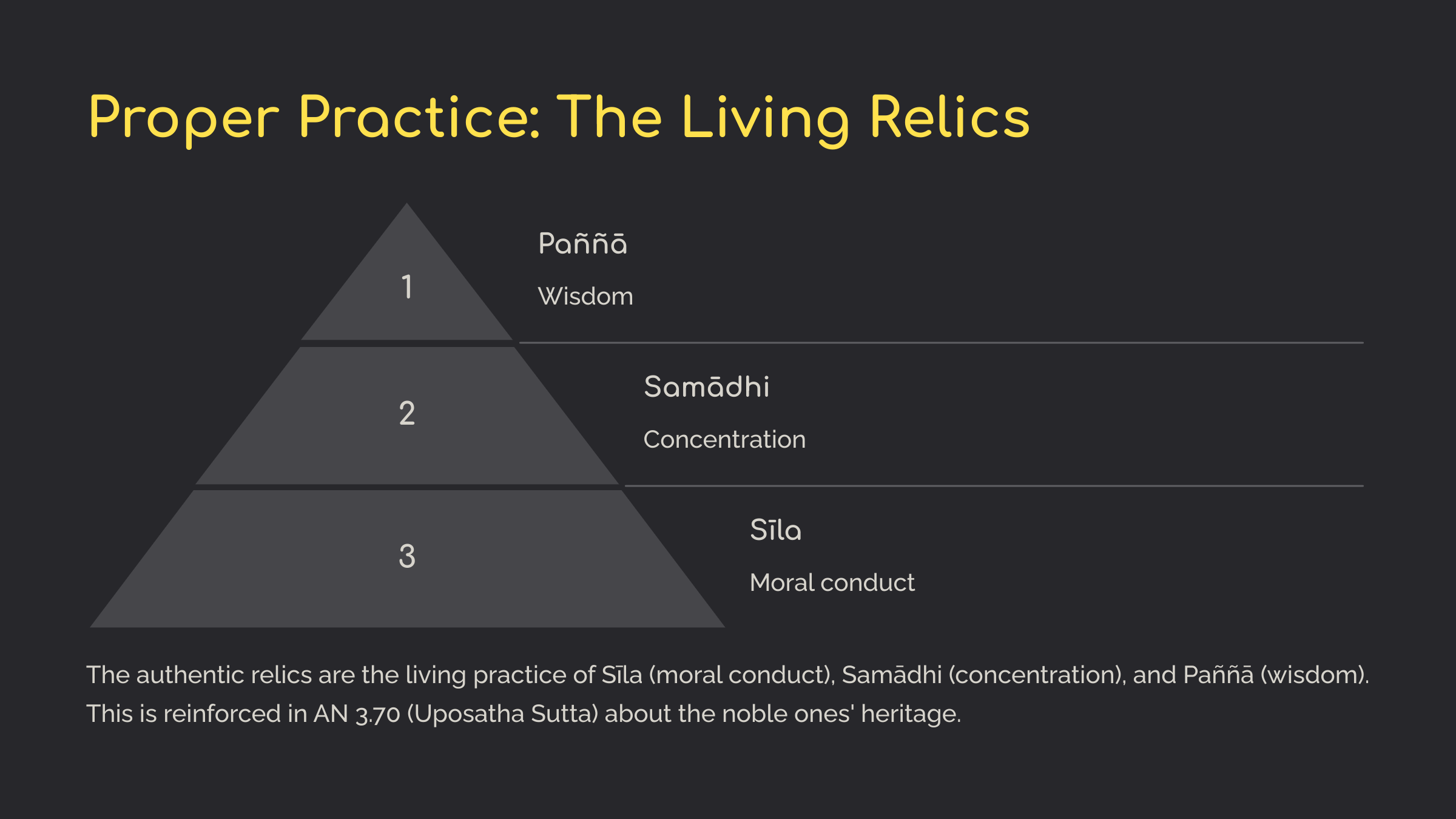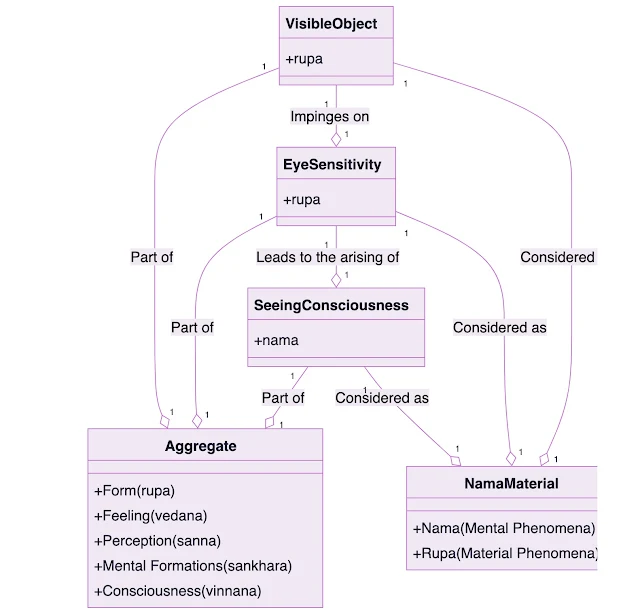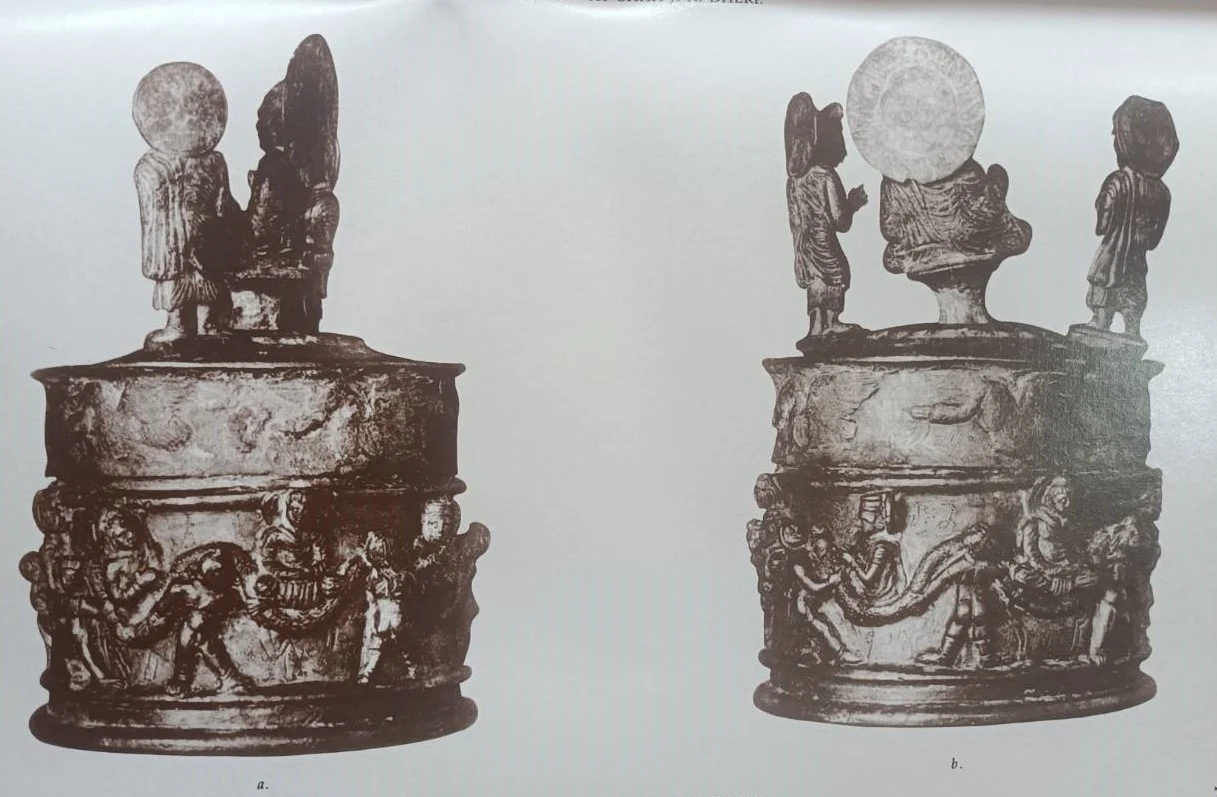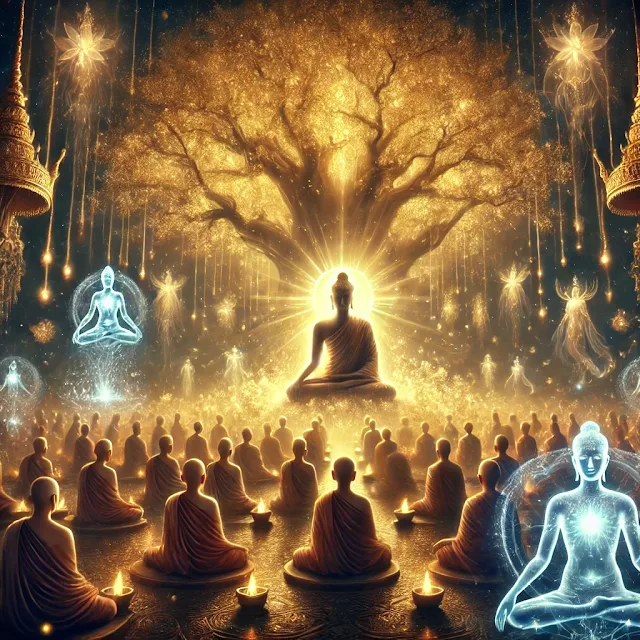1. As Objects of Devotion and Remembrance:
The Buddha recognized that physical reminders would help practitioners maintain their faith and practice. In the Mahaparinibbana Sutta (DN 16), the Buddha designated four places worthy of pilgrimage (cattāri saṃvejanīyaṭṭhānāni):
"These four places, Ananda, should be seen by the faithful... Which four?
- Lumbini, where the Tathagata was born
- Bodhgaya, where he attained supreme enlightenment
- Sarnath, where he first turned the wheel of Dhamma
- Kushinagar, where he attained parinibbana"
2. For Spiritual Development:
The relics serve as aids for contemplation and developing mindfulness of the Buddha (buddhānussati). As taught in AN 6.10, recollection of the Buddha leads to joy (pāmojja) and tranquility (passaddhi), supporting deeper practice.
The Dhammapada emphasizes the proper approach to veneration:
"Better than a thousand meaningless verses is one meaningful verse, hearing which brings peace." (Dhp 101)
3. Unity of the Sangha:
The distribution of relics after the Buddha's parinibbana, as recorded in DN 16, promoted harmony and helped spread the Dhamma. This historical event demonstrates the skillful means (upāya) used to prevent conflict and establish Buddhism across different regions.
4. Teaching Impermanence:
The relics powerfully illustrate the Buddha's teaching on impermanence (anicca). In SN 22.87 (Vakkali Sutta), the Buddha states:
"Enough, Vakkali! What is there to see in this foul body? One who sees Dhamma sees me; one who sees me sees Dhamma."
Important Considerations Regarding Relic Veneration:
1. Avoiding Attachment:
The Buddha cautioned against attachment to physical forms. In MN 22 (Alagaddūpama Sutta), he teaches:
"You should abandon even dhamma, let alone what is not dhamma."
The three genuine refuges (tisaraṇa) are:
- Buddha - The enlightened mind
- Dhamma - The truth and teachings
- Sangha - The noble community
As taught in Dhp 188-192, true refuge lies in the Triple Gem, not in external objects.
3. Proper Practice:
The authentic relics are the living practice of:
- Sīla (moral conduct)
- Samādhi (concentration)
- Paññā (wisdom)
This is reinforced in AN 3.70 (Uposatha Sutta) about the noble ones' heritage.
4. Skillful Contemplation:
When visiting relics or sacred sites, one should reflect:
- On impermanence (anicca)
- On the Buddha's virtues
- On applying the teachings in daily life
The Dhammapada beautifully summarizes this approach:
"Better than a hundred years lived without seeing the supreme truth is one day lived seeing it." (Dhp 115)
Additional Guidance:
For those seeking to deepen their practice through relic veneration, the Buddha taught in AN 4.170 that proper devotional practices should be accompanied by:
1. Unwavering confidence in the Buddha
2. Unwavering confidence in the Dhamma
3. Unwavering confidence in the Sangha
4. Noble virtues dear to the ariyas
1. Developing Right Motivation:
The Buddha emphasized the importance of proper motivation in AN 1.287:
"Monks, just as the dawn is the forerunner of the sunrise, so is right view the forerunner of wholesome states."
When approaching relics, one should:
- Avoid seeking magical powers (iddhi)
- Move beyond mechanical merit-making (puñña)
- Strengthen commitment to practice (paṭipatti)
- Use them as inspiration for the Noble Eightfold Path (ariya aṭṭhaṅgika magga)
As taught in Dhp 276:
"You yourselves must strive; the Buddhas only point the way."
2. Contemplation Guidelines:
The Satipaṭṭhāna Sutta (MN 10) provides a framework for mindful reflection:
- Examine one's sīla (moral conduct)
- Consider practical application of Dhamma
- Maintain present-moment awareness
- Cultivate wisdom (paññā)
3. True Veneration:
In DN 16 (Mahāparinibbāna Sutta), the Buddha states:
"Therefore, Ananda, be islands unto yourselves, refuges unto yourselves, seeking no external refuge; with the Dhamma as your island, the Dhamma as your refuge, seeking no other refuge."
This teaching is reinforced in AN 4.21:
"One honors the Tathāgata by practicing Dhamma in accordance with Dhamma."
4. Practical Application:
The Buddha taught in SN 47.9 (Gilāna Sutta) that mindfulness should be our true refuge:
- Maintain mindfulness of body (kāyānupassanā)
- Observe feelings (vedanānupassanā)
- Watch the mind (cittānupassanā)
- Examine mental qualities (dhammānupassanā)
5. Essential Reminder:
As emphasized in Dhp 364:
"The gift of Dhamma excels all gifts;
The taste of Dhamma excels all tastes;
The joy of Dhamma excels all joys;
The destruction of craving overcomes all suffering."
Practical Guidelines for Relic Visitation:
1. Before visiting:
- Establish pure intention (cetanā)
- Reflect on the Buddha's qualities
- Prepare mind for contemplation
2. During the visit:
- Maintain mindfulness (sati)
- Practice loving-kindness (mettā)
- Reflect on impermanence (anicca)
3. After visiting:
- Apply insights to daily practice
- Share merits with all beings
- Renew commitment to the path
As the Buddha taught in AN 3.70:
"These three things lead to the uplift of the wise: noble conduct, noble concentration, noble wisdom."
"Whoever, Ananda, practices the Dhamma in accordance with the Dhamma, that one honors, reveres, and serves the Tathagata with the highest homage."
This approach aligns with the Buddha's emphasis on practical application rather than mere devotional acts. As stated in Dhp 183:
"To avoid all evil, to cultivate good, and to cleanse one's mind — this is the teaching of the Buddhas."
The Process (Vithi):As explained in the Abhidhamma and commented on in the Visuddhimagga:1. Cakkhu-pasada (eye-sensitivity) meets visible object
2. This contact triggers cakkhu-vinnana (eye-consciousness)
3. Along with cakkhu-vinnana, three other mental factors arise:
- Vedana (feeling)
- Sanna (perception)
- Cetana (volition)
The Five Aggregates (Panca Khandha) in this process: As taught in SN 22.56:
1. Rupakkhandha (Material aggregate):
- Eye-sensitivity
- Visible object
2-5. Namakkhandha (Mental aggregates):According to AN 3.61:- Vinnana (consciousness)
- Vedana (feeling)
- Sanna (perception)
- Sankhara (represented here by cetana)
This process illustrates important Buddhist principles:
- Dependent Origination (Paticca-samuppada)
- Non-self nature (Anatta)
- Momentariness of consciousness
In AN3.61, the Buddha explains that consciousness arises dependent on conditions, comparing it to a fire that is named according to its fuel. Similarly, eye-consciousness arises dependent on eye-sensitivity and visible objects.The Process Components:
1. Citta (Consciousness):
- The basic awareness of the visible object
- The "knowing" element
2. Cetasika (Mental States/Factors):
- Vedana: feeling/sensation
- Sañña: perception/recognition
- Cetana: volition/intention
3. Rupa (Material Elements):
- Eye-sensitivity (cakkhu-pasada)
- Visible object
This illustrates the fundamental teaching that every moment of experience consists of:
- The knowing consciousness (citta)
- Its accompanying mental factors (cetasika)
- Physical base and object (rupa)
This analysis is crucial for:
- Understanding the non-self nature (anatta)
- Seeing dependent origination (paticca-samuppada)
- Developing insight meditation (vipassana)
As stated in the Abhidhamma, citta never arises alone but always with cetasikas. This shows the interdependent nature of mental phenomena.In the Seeing Process:
1. Rupa (Material Phenomena):
- Eye-sensitivity (physical sense base)
- Visible object
2. Nama (Mental Phenomena):
- The consciousness that knows/is aware of the visible object
This nama-rupa analysis is crucial because:
- It's simpler than the detailed citta-cetasika-rupa analysis
- It's more practical for beginning vipassana practice
- It helps break down the illusion of a solid "self"
As the Buddha taught in MN28:
"Just as when two sheaves of reeds are standing leaning against each other, so too, with nama-rupa as condition, consciousness comes to be; with consciousness as condition, nama-rupa comes to be."
In Meditation Practice:
1. First note the basic distinction:
- Physical elements (rupa)
- Knowing/experiencing element (nama)
2. Observe how:
- They arise together
- They depend on each other
- Neither exists independently
Practical Application in Meditation:
1. Mindfulness of Seeing Process:
- When practicing, note the moment of seeing
- Observe how consciousness arises with feeling, perception, and volition
- Notice these are separate phenomena, not a "self" that sees
2. Development of Insight:
- Start recognizing the difference between:
* The physical base (eye and object)
* The mental experience (consciousness and mental factors)
- See how they work together yet are distinct
3. Breaking Down the Illusion of Self:
As stated in SN22.59 (Anatta-lakkhana Sutta):
"Form, feeling, perception, formations, consciousness are not-self. If they were self, they would not lead to affliction."
Practical Steps:
1. Begin with simple awareness of seeing
2. Notice the feeling tone (vedana) that arises
3. Observe how perception (sañña) labels the object
4. Watch how volition (cetana) responds
5. See how all these factors arise and pass away
This understanding leads to:
- Direct knowledge of impermanence (anicca)
- Understanding of unsatisfactoriness (dukkha)
- Realization of non-self (anatta)Practical Meditation Guidelines:
1. Initial Observation:
Following MN 10 (Satipaṭṭhāna Sutta):
- Note physical base (rūpa)
- Observe mental experience (nāma)
- Watch their interaction
2. Deeper Investigation:
As taught in SN 35.28 (Āditta Sutta):
- Notice how eye and forms are "burning"
- See how consciousness arises dependently
- Observe the impermanent nature
3. Development of Insight:
Following AN 4.41:
- Develop direct knowledge (abhiññā)
- Cultivate full understanding (pariññā)
- Realize complete abandonment (pahāna)
The Buddha's teaching in SN 35.93 emphasizes:
"In the seen, there will be merely the seen;
In the heard, merely the heard;
In the sensed, merely the sensed;
In the cognized, merely the cognized."
This systematic analysis supports:
1. Breaking down the illusion of self
2. Understanding dependent origination
3. Developing insight meditation
This teaching is commonly found in:
"Monks, just as the dawn is the forerunner of the sunrise, so is right view the forerunner of wholesome states."
2. AN 3.61:
Teaches how consciousness is named according to conditions, like a fire named by its fuel.
3. MN 28 (Mahāhatthipadopama Sutta):
Contains the simile of the two sheaves of reeds explaining nama-rupa and consciousness interdependence.
4. SN 22.59 (Anattalakkhaṇa Sutta):
"Form, feeling, perception, formations, consciousness are not-self. If they were self, they would not lead to affliction."
1. AN 4.45 (Rohitassa Sutta)
- A shorter sutta (2,872 characters)
- Deals with the famous dialogue between Buddha and Rohitassa about traveling to the end of the world
2. SN 22.87 (Vakkali Sutta)
- Medium length (9,721 characters)
- Contains the famous teaching to Vakkali: "One who sees the Dhamma sees me; one who sees me sees the Dhamma"
3. MN 22 (Alagaddūpama Sutta)
- Longer text (31,602 characters)
- The Snake Simile Sutta, teaching about proper grasp of the Dhamma
Additional Referenced Teachings:
4. AN 3.42 (Tiṭhāna Sutta)
- Guidance on proper mental attitudes
5. SN 55.21-22 (Mahānāma Suttas)
- Instructions on faith and practice for lay followers
6. MN 77 (Mahāsakuludāyi Sutta)
- Teachings on proper veneration
7. Dhp 364-365:
"The Dhamma protects one who lives by the Dhamma"
"Not by another is one protected"





























